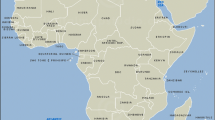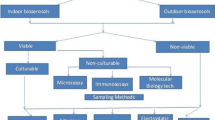Abstract
A biomonitoring study, using transplanted lichens Flavoparmelia caperata, was conducted to assess the indoor air quality in primary schools in urban (Lisbon) and rural (Ponte de Sor) Portuguese sites. The lichens exposure period occurred between April and June 2010 and two types of environments of the primary schools were studied: classrooms and outdoor/courtyard. Afterwards, the lichen samples were processed and analyzed by instrumental neutron activation analysis (INAA) to assess a total of 20 chemical elements. Accumulated elements in the exposed lichens were assessed and enrichment factors (EF) were determined. Indoor and outdoor biomonitoring results were compared to evaluate how biomonitors (as lichens) react at indoor environments and to assess the type of pollutants that are prevalent in those environments.




Similar content being viewed by others
References
Almeida SM, Canha N, Silva A, Freitas MC, Pegas P, Alves C, Evtyugina M, Pio CA (2010) Children exposure to atmospheric particles in indoor of Lisbon primary schools. Atmos Environ. doi:10.1016/j.atmosenv.2010.11.052
Canha N, Freitas MC, Almeida SM, Almeida M, Galinha C, Wolterbeek HT (2010) Indoor school environment: easy and low cost to assess inorganic pollutants. J Radioanal Nucl Chem 286:495–500
Canha N, Almeida M, Freitas MC, Almeida SM, Wolterbeek TH (2011) Seasonal variation of total particulate matter and children respiratory diseases at Lisbon primary schools using passive methods. Proc Environ Sci 4:170–183
Bargagli R, Monaci F, Borghini F, Bravi F, Agnorelli C (2002) Mosses and lichens as biomonitors of trace metals. A comparison study on Hypnum cupressiforme and Parmelia caperata in a former mining district in Italy. Environ Pollut 116:279–287
Sloof J (1995) Lichens as quantitative biomonitors for atmospheric trace-element deposition, using transplants. Atmos Environ 29:11–20
Marques AP, Freitas MC (2005) Cell-membrane damage and element leaching in transplanted Parmelia sulcata lichen related to ambient SO2, temperature, and precipitation. Environ Sci Technol 39:2624–2630
Rzepka MA, Tran DT, Alleman LY, Coquelle I, Cuny D (2010) Biomonitoring of indoor air genotoxic properties in ten schools using Scindapsus aureus. Int J Environ Health 4(2/3):224–234
Corte F (1987) The k0-standardization method—a move to the optimization of neutron activation analysis, Agregé Thesis, Gent University, Belgium
Dung HM, Freitas MC, Blaauw M, Almeida SM, Dionísio I, Canha NH (2010) Quality control and performance evaluation of k0-based neutron activation analysis at the Portuguese Research Reactor. Nucl Instrum Methods Phys Res A 622:392–398
Godinho RM, Freitas MC, Wolterbeek HT (2004) Assessment of lichen vitality during a transplantation experiment to a polluted site. J Atmos Chem 49:355–361
Frati L, Brunialti G, Loppi S (2005) Problems related to lichen transplants to monitor trace element deposition in repeated surveys: a case study from Central Italy. J Atmos Chem 52:221–230
Godinho RM, Wolterbeek HT, Verburg T, Freitas MC (2009) Accumulation of trace elements in the peripheral and central parts of two species of epiphytic lichens transplanted to a polluted site in Portugal. Environ Pollut 157:102–109
Canha N, Freitas MC, Almeida SM, Pacheco AMG (2010) Element-enrichment factors in Parmotrema bangii and Cryptomeria japonica of Portuguese islands of the central North Atlantic. Int J Environ Health 4(2/3):120–136
Mason B, Moore CB (1982) Principles ofgGeochemistry. Wiley, New York, p 46
Almeida SM, Pio CA, Freitas MC, Reis MA, Trancoso MA (2005) Source apportionment of fine and coarse particulate matter in a sub-urban area at the Western European Coast. Atmos Environ 39:3127–3138
Acknowledgments
Financial support by Fundação para a Ciência e a Tecnologia (FCT; Portugal) through research contract PTDC/SAU-ESA/65597/2006 is gratefully acknowledged. N. Canha thanks FCT for his PhD grant.
Author information
Authors and Affiliations
Corresponding author
Rights and permissions
About this article
Cite this article
Canha, N., Almeida-Silva, M., Freitas, M.C. et al. Lichens as biomonitors at indoor environments of primary schools. J Radioanal Nucl Chem 291, 123–128 (2012). https://doi.org/10.1007/s10967-011-1259-8
Received:
Published:
Issue Date:
DOI: https://doi.org/10.1007/s10967-011-1259-8




